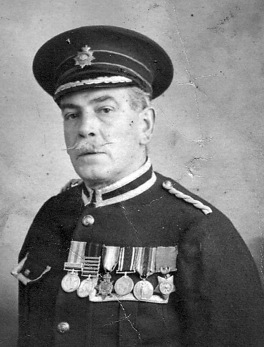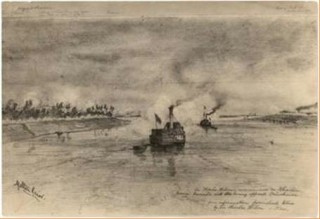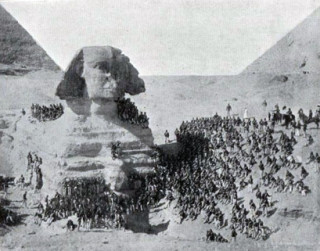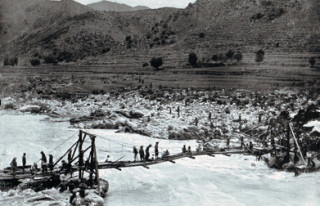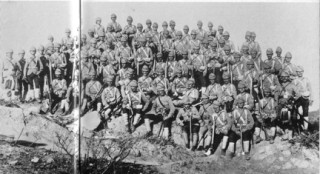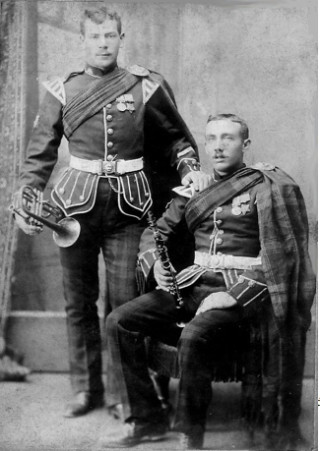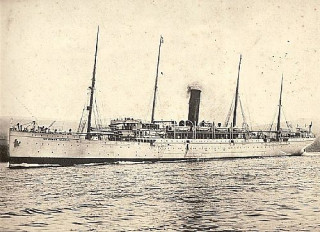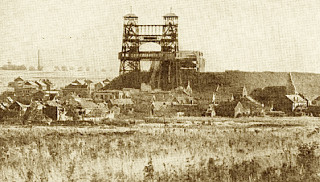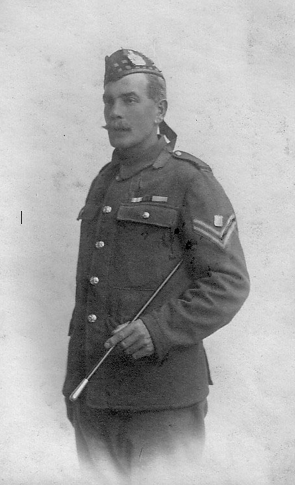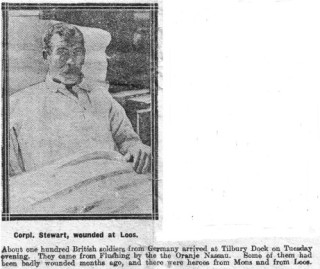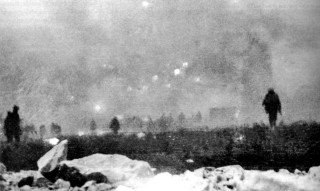John William Stewart (b. 1871; d. 1934)
A Soldier Of The Kings Own Scottish Borderers
Stan Stewart
My Grandfather, John William Stewart died in 1934, two years before I was born. I knew very little about him, other than that the family was proud that he served in the KOSB and he had a shoe box full of medals. So, when I started researching my family history, I was fortunate in being able to obtain his service records and these helped me to piece together the story of his military life. I was able to bring this story alive by reference to two wonderful books ‘All The Blue Bonnets’ by Robert Woolcombe and ‘1915 The Death Of Innocence’ by Lyn Macdonald, and, of course, the internet, for maps & photographs.
From his service records we know that he enrolled in Edinburgh on Tuesday 1st May 1888 in the Kings Own Scottish Boarderers, the KOSBs. At that time he was 19 years and 11 months old, and was serving in the 3rd Battalion of the Durham light Infantry.
The records show that he was placed in the 2nd Battalion of the KOSB, based at that time in Aldershot. The battalion was shipped out to Egypt ten weeks later on Wednesday 18th July 1888. You can imagine the excitement he must have felt going overseas for the first time.
The British Army had maintained a presence in Egypt since the Anglo Egyptian war of 1882, and was there to protect British interests in the Suez Canal. The 2nd Battalion was quartered in the Citadel in Cairo, commanded by Lt. Colonel Talbot Coke.
Three years before this, In January 1885, General Gordon had been killed by the forces of the Mahdi in the siege of Khartoum. The Mahdi himself died later of Small Pox, but there was no real peace in the area.
The Sudan was nominally under Egyptian rule, but then a new Messiah arose in the Nubian Desert, Osman Digma, who proclaimed himself Mahdi.
Earlier in the year all trade with the Sudanese interior was stopped to prevent the Mahdists obtaining money for arms, as it was known that it was their intention to invade Egypt.
Suakim was the last government outpost, and Osman Digna was opening up trenches in front of the Suakim water forts, threatening the town’s water supply. It was decided that for the safety of Suakim, the Mahdists must be driven from their entrenchments. The task was beyond the local garrison. In Egypt, the Sirdar, Major General Sir Francis Grenfell, was placed in command of the expeditionary force.
Late one night at the end of November 1888, the KOSB 2nd Battalion received orders to proceed, on active service, to the Red Sea port of Suakim, in the Sudan, which was being held by a small garrison of Egyptian and Sudanese troops, as this was now under siege by the Mahdi. The KOSB 2nd Battalion left Cairo full of high spirits and enthusiasm at the prospect of action. They endured a very uncomfortable journey down the coast in a number of Khedivial postal steamers, due to the heat, flies and cramped conditions. The battalion finally assembled at Suakim on 8th December for the defence of the town and port, and took up lines in the fortifications.
Their uniform included a scarlet jacked, which would have made them very easy to see, and they were armed with Martini-Henry rifles, identical to those used in Africa at Rorks-Drift. I have personally fired a Martini-Henry rifle, and found it to have a very severe recoil when compared to the more modern 0.303 inch and 7.62mm rifles that I have also fired. This recoil used to strike fear into new recruits until they learned to hold it very firmly into the shoulder. This relatively heavy recoil comes from its much larger diameter bore. 0.47 inches against the Lee Enfield 0.303 inches. As the force is proportional to area, this represents more that twice the recoil force.
Marksmen were sent daily into the Water Forts to fire at the Dervishes who were about half a mile away. By night the Dervishes brought out a gun and shelled the battalions lines, which were 1,500 yards on the Suakim side of the Water Forts. Between the two Water forts was an embankment, twenty foot high, and the battalion moved up and spent the day under fire converting the embankment to a parapet for rifles, while marksmen in the forts gave covering fire. When the parapet was completed the whole battalion was brought into action on the embankment and swept the Mahdist trenches and the bush beyond with company volley fire.
Then, on 20th December, at 5am, the Borderers paraded for battle. Heavily laden, they marched out to the embankment again, each with 140 rounds of ammunition, rations for a day, greatcoats rolled on their waistband, haversacks, water bottles and five sandbags. One man in three carried an entrenching tool. Reaching the embankment without attracting enemy fire they lined the parapet and fired company volleys at the Dervish lines. Marksmen were again in position in the forts. Also in position were the 1st Welsh Regiment and an Egyptian battalion. At 7.30am, General Grenfell and his staff arrived at Fort Gemaiza, the southern Water Fort, where a signalling station had been set up to direct operations.
Out of the bush on the northern flank, two brigades of Egyptian and Sudanese troops, led by British officers now attacked the Dervish Trenches. There was a lot of heavy fire, and in the words of General Grenfell The Mahdists ‘showed a good front’ and seemed about to charge, but eventually their trenches on that flank were taken on the point of a bayonet. An officer who was making an unusual mark in the service commanded one of the attacking brigades. That officer was Colonel Herbert Kitchener, Later Lord Kitchener.
General Grenfell then ordered the Borderers to advance from the northern Water Fort, Fort Shaata. The Battalion moved around the fort and emerged into the open, in column, conspicuous in their scarlet jackets, and marched forward into the brisk fire from the Mahdist centre. By a remarkable stroke of luck only one casualty was sustained, for it turned out that the Mahdists had removed the backs-sights from their rifles in the belief that they could shoot straighter without them.
Gradually forming a double column on the march, the battalion formed square on nearing the northern section of the enemy trenches. Reaching the trenches the borderers halted, still in square, and set to work to form a defensive enclosure.
The Sudanese battalions had now obtained possession of the remaining Mahdist trenches; the retreating enemy were being shelled. By 8.15am the battle was won. At least 1000 enemy had been put to flight from their skilfully prepared trenches, as well as horsemen and several hundred spearmen. The cost to them being 500 dead.
And so ended the spirited action of Gemaiza, named after the southern Water Fort where General Grenfell had his command post. On 27th December, not three weeks from their disembarkation at Suakim, the Borderers re-embarked for Cairo.
News of the victory reached the UK and the front pages of the newspapers were filled with articles, and drawings, of their versions of the action.
The patriotic fervour, whipped up by the news of the victory, and the way it was presented by the newspapers, was increased further when Queen Victoria agreed to the granting of the Sudan Medal, with the clasp ‘Gemaiza’ and the wearing of the Bronze Star conferred by the Khedive, to those who took part in the battle.
Six months later, in June 1889, a Dervish army outflanked the forts at Wadi Halfa and advanced through the desert and established themselves close to the Nile at Abu Simbel. It was decided to form a brigade of British troops without delay at Aswan. The Advance party of 2nd Battalion KOSB, three companies, left Cairo by rail for Asyut, and there transferred to the Thomas Cook river steamer Cleopatra. The steamer towed a barge containing men of the Royal Irish Rifles; the barge leaked and twice had to be run ashore and bailed out for the leak to be repaired. On 3rd August they reached Luxor, shortly followed by the main body of the battalion in another Cook’s steamer. However, the Borderers hopes of further action were dashed when a telegraphed order to proceed no further south was received at Luxor. When the advanced party was within twenty miles of Aswan. The Sirdar had inflicted a terrible defeat on the Mahdists at Toski, 10,000 of their number being captures or killed. The Borderers returned to Cairo.
In 1889, the Regiment celebrated its bicentenary, and the entire 2nd Battalion were photographed standing at the Sphinx.
On January 2nd 1890 the 2nd Battalion went by rail to Suez, to embark for Bombay. The battalion diary gives the strength as 25 Officers, 2 Warrant Officers, 28 Sergeants, 14 Drummers, 37 Corporals, 750 Privates, 3 Officers Ladies and 5 Children, 22 Women and 36 Children.
The Battalion disembarked at Bombay on Wednesday, 15th January 1890 and travelled to the hill station of Sabathu, near Simla. In 1891, At the camp of exercise at Ambala, they were inspected by the Commander-in Chief in India, Sir Frederick Roberts, who found them to be ‘clean and smart and drilled well’
(I have visited India many times, and each time I tried to visualise my Grandfather being there with the Army, but I did not know at that time which parts of India he had been in, until I recently obtained a copy of his Army Records.)
In the 1893-94 trooping season, the Battalion moved from Lahore to Rawalpindi, where Lt. Colonel Henry Dixon arrived from England to assume command. Dixon had been with the Battalion for just 6 days when he received a telegram:
‘Your Battalion is directed to mobilize in view of operations in Bajaur via Swat. Field Service clothing summer scale to be obtained in bulk, but not issued to individuals without further orders’
The Borderers entrained for the Northwest frontier, and at Hoti Mardan, near Nowshera, joined the force designated ‘The Chitral Relief Force’
The Small state of Chitral lay at the extreme north of the Frontier, sandwiched between Afghanistan and Kashmir, in the shadow of the snows of the Hindu Kush, the Pamirs, and the northern ramparts of the Korakoram range.
In 1882 its ruler was murdered, and Dynastic feuds broke out. Under the Durand Agreement of 1883, the Indo-Afghan frontier was redefined, a belt of land of quasi-independent tribal territory under Brutish political control was recognised. Nevertheless, Afghan intrigue was at work, and eventually a Pathan chief, Umra Khan, invaded Chitral and besieged the fort at the capital itself. Within, the British Political Agent who had been sent from Kashmir, 5 British Officers with a detachment of the 14th Sikhs, together with a few hundred Kashmir Imperial Service troops and a handful of local levies, clerks, servants and followers, totaling 543 persons were the total within the fort.
They had 300 rounds of ammunition per man, and on half rations could last for two and a half months.
Accordingly, the Chitral Relief Force was assembled at Nowshera. Ahead lay a northward march of 150 miles across mountains and rivers in spate.
A general advance was made from Hoti Mardan on 1st April 1895. As there was not enough transport, the troops marched without tents and without the full field-service kit. It is interesting to note that the personal baggage allowed was 80lb for Staff officers, 53.5lb for other Officers, 40lb for Warrant Officers, 32lb for native Officers and 16lb for others. The British and Indian NCOs and men were issued with the new 0.303 Lee-Metford, the first magazine rifle, in place of their Martini-Henry rifles.
The troops marched with twenty days supply of rations, and all the baggage in its due order; first and second reserves of ammunition, entrenching tools, cooking pots, sick litters, field hospitals, kits and spare animals.
First the frontier hills had to be crossed, then the Swat valley. Information received indicated that several thousand Swati tribesmen were determined to resist an advance through their country. On the 2nd April the column reached the village of Dargai, about 4 miles from a rugged entrance to the hills, The Malakand Pass. Heavy rain had fallen during the previous night and throughout the morning, but morale was high and the men seemed indifferent to exposure. They had bivouacked overnight under waterproof sheets in the ceaseless rain at Dargai.
At 7am the order was given to the Brigade to advance, reinforced by mountain batteries and Bengal Sappers and Miners. An eyewitness reported that it was a beautiful morning, clear and fresh after the rain. The troops advanced up a level fertile valley that gradually narrowed and curved to the north-east. The rebels held a formidable position, and it was afterwards estimated that it had been held by 10,000 tribesmen, half of which had firearms.
The storming of the Malakand Pass began at 8.30am when the guides moved up the centre of the valley to reconnoitre. At a point they came under heavy fire, and the KOSB pushed forward with their Maxim machine gun. However the range was too great, and they were ordered to retire. The mountain batteries were briefly turned towards the village area. The general’s intention had been to turn the flanking heights, but scaling the heights was proving difficult and slow.
At midday a frontal attack was ordered. The batteries had moved to within 1,000 yards of the enemy positions, and their fire was becoming very accurate, nevertheless,
The tribesmen remained firm enough to face the bayonet. The Borderers were given the centre spur of the hillside and the Gordon Highlanders the spur on their right. The men began to climb through thick scrub under heavy, but erratic fire. The Borderers Maxim gun was brought into play, together with the mountain batteries, covering the advancing bayonets as each sangar was rushed. Often these sangars were only taken after hand-to-hand fighting. An officer serving on the General’s staff later wrote ‘It was a fine and stirring sight to see the splendid dash with which the two Scottish regiments took the hill’
The first company of KOSB was lead by Capt. D. Macfarlane, who was severely wounded. 2nd Lt. Coke was shot through the hip and received a sword wound in the leg. Borderers lost two men killed and fourteen wounded. There was a pause below the crest of the hill, to allow the many small groups to reassemble. Then the bugles sounded along the line, and with bayonets fixed, both the Borderers and the Gordon Highlanders on their right, stormed the crest.
The Borderers made the final charge on the enemy’s village. After a five hour action the Malakand pass had been taken. The next day the Borderers moved up through the Malakand pass and bivouacked in the Swat Valley, and then advanced to Thana on the Swat River. Orders were issued for the crossing. It was a characteristic of the mountain tribesmen that they feared the power of the horse, and as the Guides Cavalry and Bengal Lancers appeared in the valley, the enemy, although massed in numbers, showed little heart for disputing the river crossing. At first, from a good position on the far bank in rocky ground, their fire was too uncomfortable for bridging operations.
Then the KOSB and the 4th Sikhs were moved up, and under their covering fire the 11th Bengal Lancers crossed by a ford. The Borderers followed, wading through the current with water up to their armpits. The river was half a mile wide due to the melting snows and was flowing in several separate channels and still rising, but several thousand transport mules and camels forded it without loss before a trestle bridge had been erected. On the 8th April, the Borderers lay up at a small fort, Ramora, on the north bank, near where they forded, and there ate their first cooked meal since leaving Nowshera.
The Rigours of the relief march continued. They crossed the Katgola Pass through the next range of mountains, which rose to 7000 feet, and entered a rocky valley through which the treacherous Panjkora River flowed. This river was susceptible to snows and was liable to become a roaring torrent within hours. They were now approaching Umra Khan’s own country. The 4th Sikhs crossed on rafts, but these disintegrated. A suspension bridge was constructed using telegraph wire and beams stripped from native dwellings. The bridge was completed in 48 hours and had a span of 100 feet. It successfully took the weight of all components of the Chitral Relief Force.
On 17th April the Boarderers crossed the bridge in a general advance up the Jandol valley. The campaign was as good as ended. Umra Khan had disappeared. He was reported to have fled into Afghanistan to seek asylum from the Amir. A few hundred Indian Pioneers and Kashmiri levies under Colonel Kelly actually got through to the garrison of Chitral on 20th April. The Borderers moved to the Janbatai Pass at about the time that leading troops entered the Chitral capital.
The ‘magical’ telegraph, which the British brought to India, flashed the news of the relief of Chitral to Peshawar, to Government and to the Empire. Her Majesty, Queen Victoria, sent a gracious message, which was published in Divisional orders, and tranquillity, was restored in Chitral.
The men of the 2nd Battalion who died, either in battle or through illness, were buried in a small cemetery in the mountains at Janbatai. It was a bleak enclosure without a blade of grass, marked out only by boulders. The graves were bordered by sticks and stones, and the soldier’s name and a horizontal cross were set out in pebbles, as was the epitaph ‘Gone but not forgotten’
At some time during his service in India, John William Stewart had the photograph on the following page taken in the Punjab with a fellow bandsman. He is the one standing. Both men were wearing the Sudan medal with the clasp Gemaizah, and also, with Queen Victoria’s consent, the Bronze Star awarded by the Egyptian Khedive.
In August 1895, the 2nd battalion KOSB left Janbatai and returned to Rawalpindi. It remained there for the next two years. However, John William Stewart’s service record tells us that he returned to the UK on 1st February 1896. It can only be guessed that this return to a home posting was because he had served for just over six years in India, and had been on continuous overseas duty since 19th July 1888. A period of eight years, and he was still only 25 years old.
Whatever the reason, we know that he must have been transferred to the 1st Battalion, as his original 2ndBattalion was still in India. This would also explain why his record of service shows him leaving for service in South Africa on 5th January 1900, which is the exact date that the 1st battalion embarked for South Africa.
The British Army in South Africa were obliged to put into the field a quarter of a million men, in addition to contingents from the Empire. The 1st Battalion KOSB embarked for South Africa from Aldershot on 5th January 1900. Eye witness accounts say ‘Reveille was at 3am and we marched to the station and got on the train at 8.15am for Southampton, arriving there at about midday. There were small stalls about the platforms and we could hear them cry out now and again ‘Tommy Atkins can have free cakes, coffee and notepaper. They were to sail in the Braemar Castle and had to work hard to get all the baggage aboard. They found the boat to be a good one and quite roomy’.
“There were mothers and sisters galore to see us off, and we sailed at about 5pm amidst much weeping and cheering and the playing of the pipes”. The battalion embarked with a strength of 28 officers and 1,082 other ranks.
The Boer (the Dutch word for farmer) was fighting for his nationhood, and he was very effective with his fast pony and German rifle. He engaged British regular forces whose numbers exceeded the entire Boar population of the two republics of the Transvaal and the Orange Free State. After initial humiliations, when British troops were besieged at Kimberly. Mafeking and Ladysmith, field marshal Lord Roberts was sent out to bring the Boar to book, with Kitchener as his second in command.
Meanwhile, on the 26th January 1900, the 1st Battalion, KOSB, including John William Stewart, disembarked at Cape Town, entrained for the Orange River where it came under the 7th Division and marched to Paardeberg in pursuit of the Boar General, Cronje. After one of the harshest of marches, the 1st Battalion KOSB were present when General Cronje surrendered to Lord Roberts at the Modder River.
Before General Cronje surrendered, he tried to escape but was repulsed and then finally surrendered unconditionally, together with his 4,000 men. There was great rejoicing in the British camp at the news. An eye-witness reported that at about 3am we were ready to receive an invasion later in the morning, but instead, we could see a Cronje’s white flag flying, and all his force collecting around it, preparing to surrender. Kitchener and his escort went to receive all the prisoners.
On Roberts great march through South Africa, the 1st Battalion, which included John William Stewart, entered Bloemfontein on 14th March 1900. The men were still on half rations, and the troops and transport animals alike were exhausted from the day- long marches. However at Bloemfontein there was a welcome halt. Then at the end of the march the Borderers took part in the capture of a ridge of hills to the north, and formed the most advanced outpost of the army. Dislodging the Boers from the hills the Battalion fought its most disastrous action of the war at Karee Siding, incurring 83 casualties. A member of the Battalion later wrote the following in a letter home. ‘We were about 100 yards of the enemy when we were ordered to fix bayonets. The Boers fled as soon as they saw the steel glittering, for they do not like close quarter fighting.
At the end of May, the 1st Battalion crossed the Vaal River and were present at the fall of Johannesburg. Also, on the 4 June 1900, they were present when the southern forts of Pretoria. Kimberley, Ladysmith and Mafeking were relieved, whilst Baden-Powell had relieved Rustenburg. On April 1st1901, John William Stewart shipped out of South Africa and travelled home. On 30th April he was discharged from the army having served the colours for 13 years.
During his time of his first enlistment in the army he was deployed as follows
Home 1st May 1888 to 18 July 1888
Egypt 19th July 1888 to 30th Nov.1888
East Sudan 1st Dec. 1888 to 31st Dec 1888
Egypt 1st Jan. 1889 to 1st Jan. 1890
India 2nd Jan 1890 to 22nd Jan 1896
Home 1st Feb 1896 to 4 Jan 1900 (1/7/1896 he married Agnes Bywell)
South Africa 5th Jan 1900 to 31 Mar. 1901
Home 1st Apr 1901 to 30 Apr. 1901
It is known from census and marriage records that John William Stewart had problems finding employment, and that he eventually was working as a Coal Miner (Hewer) in the Brandon Colliery which is about 3 miles South West of Durham City,
As he had been a military bandsman, it was natural the he would become a member of the colliery band. I recall seeing a silver watch chain medal engraved with ‘Durham Gala 1906’ with the word ‘Cornet’ on the reverse.
The First World War was declared on Tuesday 4th August 1914. The KOSB battalions 1& 2, the reserve 3rd were mobilised. In addition, ‘Lord Kitcheners New Army’ The KOSB battalions 6th, 7th and 8th were raised in Berwick On Tweed in September 1914. John William Stewart, I believe, was not happy working on the coal face in a collier, after serving in the army for 13 years. So the outbreak the 1914 war gave him the opportunity he wanted the rejoin the colours. He wasted no time. He had his medical examination in Newcastle upon Tyne, 5 weeks later. It is interesting to note that, since his first medical, 26 years earlier, he was one inch taller, at 5 Foot 6½ inches, and, at 12 stone, he was 2 stones heavier. His chest had also grown to 37 inches from the original 34¾. He was over 43 years of age at the time. He was sworn in on 9th September 1914 and posted to the 8th Battalion KOSB at Berwick Upon Tweed, as part of Kitchener’s New Army, and was promoted to the rank the of full Corporal on 30th October 1914.
In September 1914 the Battalion moved to Bordon, Hampshire, and was assigned to the 46th Brigade in the 15th (Scottish) Division. In February 1915, the 8th Battalion KOSB, with Corporal John William Stewart, moved to Winchester, where they were billeted on the town, before moving on in April to Park House in Salisbury Plain and Chiseldon for final training. On 10th July 1915 the Battalion embarked for France and Flanders, landing in Boulogne. It must have been an exciting time for those who had never been outside the United Kingdom.
Between July and September, more than 15,000 battalions of Kitchener’s army left for France. At first, whilst the Divisions grouped, they were a good way behind the firing line with only the grumble of guns in the distance to hint at what lay ahead. Troops out of the line were marched to a scale model of a battlefield around the mining village of Loos, pronounced Loss. Rearing up beside the village were twin pit head winding gear, each topped with an ironwork turret and linked by a long steel walkway. It reminded Londoners of home and they christened it ‘Tower Bridge’
The book ‘1915 The Death Of Innocence’ by Lyn MacDonald gives a graphic account of the Battle of Loos, as does ‘True WW1 Stories’ a compilation of first hand accounts of the battle. The following is based upon those books.
his is an extract of a poem that was written after the battle:
LOOS: The Dawn Of Hope
Stiff by the loop-holed barricade
Food of the bomb and the hand grenade
Still in the slushy pool and mud
Ah, the path we came was a path of blood
When we went to Loos in the morning
On the eve of their departure to the front, Lord Kitchener drew up the Brigade for inspection. The band played the National Anthem and, as three thousand or so rifles crashed down in a General Salute, all eyes were on the legendary Kitchener. The stern face, familiar from ten thousand recruiting posters, the imposing figure, ramrod straight, the chest bearing the ribbons of medals earned in long years of campaigns and service. He moved along the ranks, with an escort of staff officers, and inspected the men with a critical eye. When he mounted the rostrum too speak to the men, he did not mince his words. He bluntly told them that their attack was in the nature of a sacrifice to help the main offensive, which was to be attempted ‘elsewhere’. He said that no attempt had been made to conceal the preparations for the attack on Loos. He congratulated them on the position of honour that had fallen to them and he wished them ‘as much luck as they could expect’ in the course of the next few days. His final words were ‘Goodbye and good luck’ Hardly an inspiring speech.
Whilst the German’s had used gas earlier in the war, the battle at Loos was to be the first time that gas was used by the British. The men of the special gas brigade moved into the front line trenches to prepare for the order to release the gas. The wind direction and strength that was forecast, was far from ideal, and the order to release would depend upon the actual condition at zero hour.
The night before the battle, the men were dressed in battle order, which meant full equipment, except for the pack. A haversack with two days rations was fixed on the back in place of the pack. Every man had two extra bandoliers of 0.303 ammunition.
Cpl. John W Stewart, and the rest of the 8th Battalion, were moved up into the support trenches at 10.30pm on 24th September 1915. They were to form the second wave of the 46th Brigade’s attack. By midnight the rain was pelting down and every man was soaked to the skin. Just before dawn, two sergeants came along the trench with a jar and a mug, telling the men to take a good swig. It was neat rum and caused a number of men to gasp, cough and splutter. For the umpteenth time platoon sergeants checked the equipment each man would take into battle.
General Douglas Haig spent a spent a sleepless night as he was painfully aware that everything depended upon the speed and direction of the wind. Forty gas officers positioned along the front, specially trained to estimate wind speed and direction, sent back reports every hour. Weather forecasts from Paris and London were relatively rough and ready. During the night, the favourable conditions that Haig had gambled upon began to look more doubtful. At 3am Captain Gold went to see General Haig. He reported that the westerly wind was still blowing, but it was impossible to rely upon this at zero hour. The wind following the south westerly was weakening and showing a tendency to turn to the south. General Haig went straight to the point. ‘What time then, in the opinion of Captain Gold, would be the most favourable fir the attack?’ Gold hesitated, then reluctant to commit himself, responded ‘As soon as possible.’ As soon as possible was dawn and the order was given.
The British wire in front of the troops was stealthily cut during the night before the attack, to allow the infantry to advance and rush across No Man’s Land to the German trenches where, they fervently hoped, their wire entanglements would have been cut to pieces by our guns. At ten to six in the morning of the 25th September, the gas was to be turned on, and forty minutes later the infantry would go over the top.
One of the officers, Lt. White, who was responsible for the release of gas in his sector, was worried that the wind had slowed down and was stopped in several places. It took him a long time to get connected to HQ, and he eventually got through to the Brigadier General with only minutes to spare. He told him of the wind conditions and said that given these he could not carry on with the release of gas. The Brigadier General told the junior officer that he was already aware that all was not well and had passed the information on to higher authority, but he had received a direct order to carry on. He gave this order to Lt, White. However, it was clear that the decision was not his. By the time Lt. White returned to the trench in the front line it was almost 6am. He ordered the gas to be turned on and the cylinders were opened.
Lt White reported that ‘the gas drifted slowly towards the German lines. It was quite visible owing to the rain, but at one or two bends of the trench the gas drifted into it. In these cases I had the gas turned off at once. At about 6.30am the wind changed and quantities of gas came over our own parapet, so I ordered all gas to be turned off and only smoke candles were to be used.’
When the gas rolled back to engulf the first line of the Kings Own Scottish Borderers, it was not surprising that they faltered and hung back. Piper Laidlaw saved the situation. Tearing off his own mask he leaped onto the parapet and started playing the bagpipes. One by one, in a trickle and then a flood, the men pulled themselves together and clambered over the parapet and began to run towards the German wire. Piper Laidlaw was wounded in the leg but continued playing. For his actions that day he was awarded the Britain’s highest honour for bravery, the Victoria Cross.
The Scottish Brigade had broken through so swiftly in the wake of the gas, pushing back the survivors with such determination, and battered there way into Loos village with such ferocity, that the German troops endeavouring to make a stand were overwhelmed. Soon observers were reporting back that crowds of Germans were seen running up the hill towards their second line of trenches.
The KOSB, in common with all the other British regiments at Loos, had never in their history experienced such high casualty figures. In some cases nearly all the officers had been killed or wounded. This would help to explain how it all went wrong. The plan was that 46th Brigade, which included the KOSB, should have advanced in a straight line, past the Chalk Pit and on across la Bassee Road to Bois Hugo. There had been next to nothing to stop them, but, the fighting in Loos had drawn them like a magnet, and they joined the others fighting their way through the village, and on to take Hill 70. The remnants of the battalions were all mixed up together, and had not followed the plan that would have allowed them to take the defences in front of Citi St. August. This was not a City, but a village, made up of miner’s dwellings. Instead, because their blood was up they could not resist joining in the pursuit of the German troops who were running to Citi St Laurent. There were fewer British now, and the dead and wounded were lying like a tartan tide across the streets of Loos and all across the valley back to the German line. Colonel Sandilands arrived at the top of hill 70 and watched, in a fury of frustration. He sent runners with orders but they were swept along with the charge that was taking place. From his viewpoint on Hill 70, the Colonel could see barricades of wire hidden by long grass invisible to the attacking troops. Behind these barricades he could see crowds of German soldiers running through the streets of Citi St Laurent to meet them and into trenches and houses, enabling them to fire from the upper storeys. The Germans held their fire until the British were less that 330 yards away. There was nowhere to go. No cover of any kind. No dip, brush or dent across the wide bare hillside. No shelter or escape from the deadly fire. No means of answering back. The Germans were having it all their own way. They fired at anything that moved and occasionally raked the thin line with machine gun fire. By the time that news of the real situation got back, it was too late for those pinned down in front of Citi St Laurent. The evidence tells us that this was where Corporal John William Stewart was wounded and taken prisoner.
This because this is the only land that was recaptured by the Germans on 25th September 1915. The Town of Loos itself remained in British hands. Kipling was a staunch patriot and when war was declared in 1914, he used all of his considerable influence to secure a commission for his son Jack, who was just 17 years old. He was successful and Jack was awarded a commission in an Irish regiment. Unfortunately Jack was mortally wounded in the mouth during the battle for Loos. He died in the Chalk Pit. On the news of his death Rudyard Kipling was distraught and became a changed man. Seeking solace, he wrote a poem about Jack, called ‘My Boy Jack’ The following is the first verse and part of the last verse of four.
My Boy Jack
“Have you news of my boy Jack?”
Not this tide
“When d’you think that he’ll be back?”
Not with this wind blowing, and this tide
In the last verse he wrote
Then hold your head up all the more
Because he was the son you bore
John William Stewart’s 8th Battalion of the KOSB lost, killed, wounded and missing nearly 400 men, of which 14 were officers. The gain in territory was not as great as had been hoped, and the great breakthrough did not happen.
John William Stewart was posted missing on the 25th September 1915. Word that he was missing was sent by telegram to his wife Her mind must have been in turmoil as she was alone with a 4 year old son, John George Stewart and her daughter Agnes Caroline Stewart, aged 15. She was living in an area that was new to her and only had what friends she had made in the last two years.
His service records show that John William Stewart, regimental number 17042, was a prisoner of war at Lazarette 4 on 1st October 1915. A Lazarette is a hospital within a prisoner of war camp. His right arm had been amputated, at about mid third of the upper section, by a Germans Surgeon. For the rest of his life he was full of praise for the high standard of medical attention that he received from the Germans medical team. He was to be part of a prisoner of war exchange scheme.
The cutting is from ‘The Illustrated Chronicle’ newspaper
The ship used for the repatriation, the ‘Oranje Nassau’, sailed from Flushing, in Neutral Holland, and docked at Tilbury on Tuesday 8th February 1916.
After being fitted with a false arm, he was discharged from the army with a pension. On 20th September 1916. He was given a civilian suit, civilian shoes, some money and a travel warrant home, together with an official discharge from the army stating that he was ‘unfit for military service.’ So ended the extensive military service of John William Stewart, He had seen action in the Sudan, India, South Africa and Flanders.
One final photograph of him in later life. He is dressed in what can only have been a civilian bandsman’s uniform, and it shows all of his medals.
He died in 1934 of natural causes and was buried in St. Giles Churchyard, Durham City. The family story was that his funeral was well attended with past comrades who marched to the churchyard behind a civilian brass band.
Discovering his experiences in the army has been, for me, a voyage of discovery. I am very proud of his record, and the achievements and of his regiment.
Stan Stewart, his Grandson.

